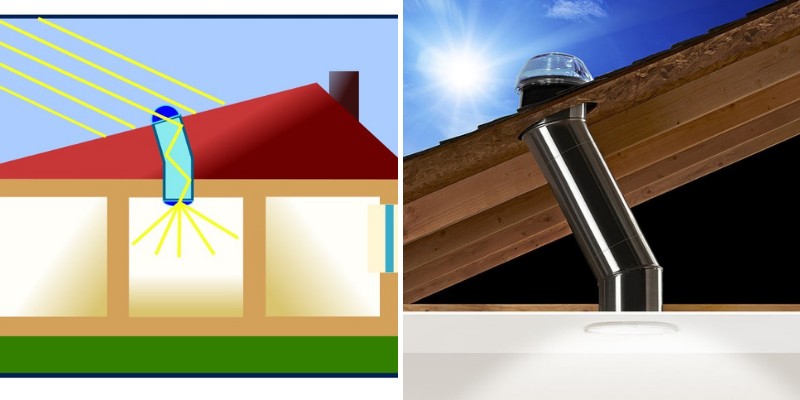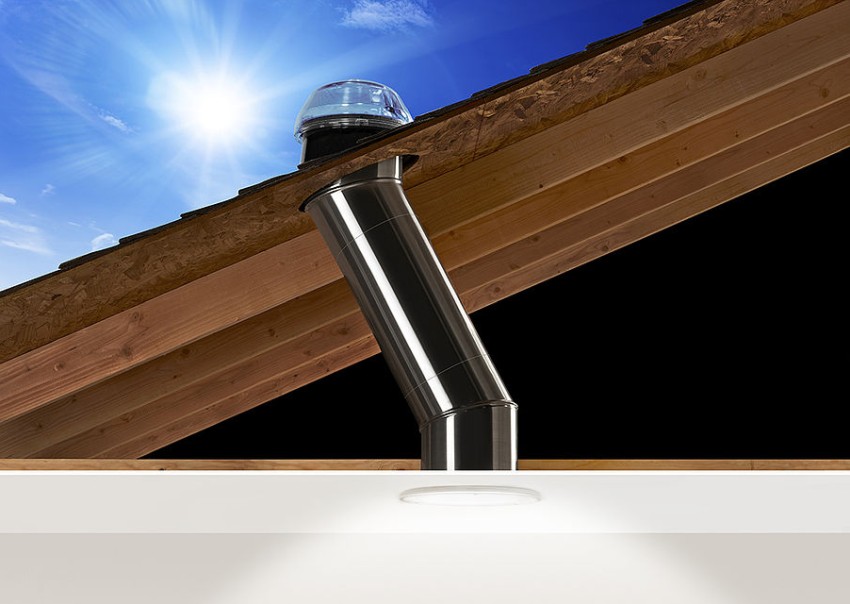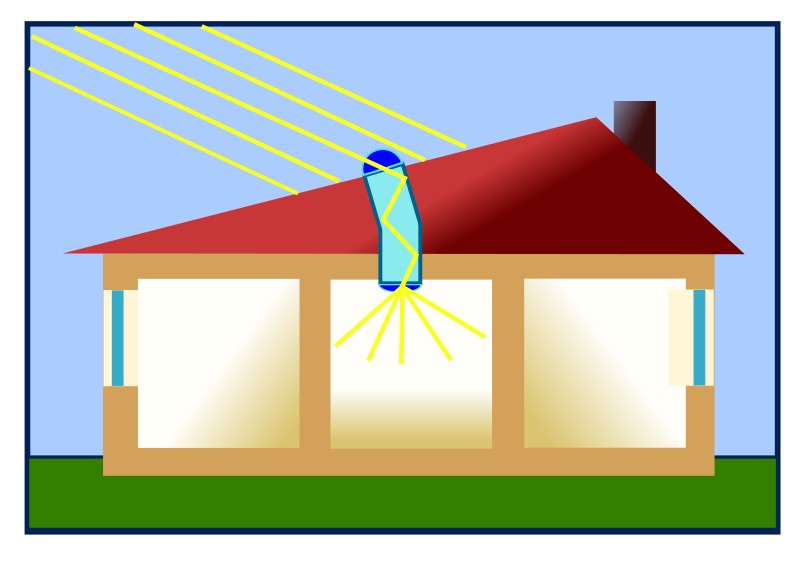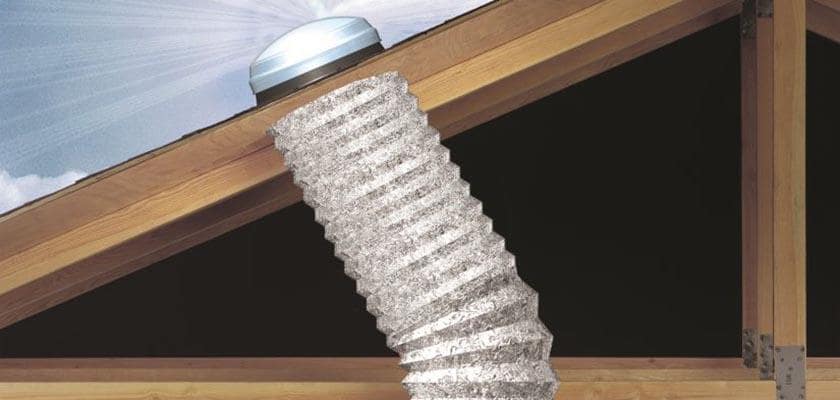Does the idea of installing solar technology in your home seem costly and involved? Remarkably, that’s not the case with Solar Tubes! (or Tubular Skylights as some people call them).

Such lighting devices are reasonably priced and simply mounted. Moreover, they bathe your home in comfortable natural light.
Often, contractors compare solar tubes to skylights, each with assets and drawbacks. Similarly, in this post, I will give you both sides of the coin.
By this, you’ll know if solar tube lighting is right for your particular home. If so, it will boost the value of your property!
Let’s see first what Solar Tubes are and then discuss some of the advantages and drawbacks of this lighting option for your home.
Solar Tubes Features
A solar tube has three main components. A transparent acrylic dome attaches to your roof, secured to a sheet metal pipe. This “tube” descends through your attic, abutting your ceiling.
The dome collects sunlight, directing it down the tube. Then, a lens in your ceiling disperses the light, illuminating the area below. Solar tubes come in diameters of 10 to 22 inches, fitting between your roof joists (most options are 10 or 14 inches).

How it Works
Polished metal lines the tube, having reflective properties. As the sunlight bounces off the metal, it becomes amplified.
Then, the focused sunlight streams through the portal in your ceiling. A diffuser in the portal broadcasts the light evenly.

Use Cases of Solar Tubes (Tubular Skylights)
Many homeowners appoint solar tubes for dim and windowless areas. Examples are closets, stairways, and halls.
They can likewise brighten various rooms, lending a soft ambiance. For this reason, they’re quite popular for bedrooms, bathrooms, laundry rooms, and kitchens.
On a sunny day, the light from a 10-inch solar tube equals that of three 100-watt bulbs. That’s enough to illuminate 200 square feet, such as for a home office.
A 14-inch tube rivals the light of four 100-watt bulbs, suiting a 300 square foot room.
For evening illumination, you can buy a solar tube that generates solar electricity. This type of model charges in daylight, running your artificial lights when darkness falls. While this design costs more, you’ll have natural light round-the-clock.
Advantages of Solar Tubes
Easily Installed
Mounting a skylight involves modifying your drywall and rafters. Thankfully, solar tubes don’t impose on your framing. For this reason, an experienced contractor can seat a solar tube within three hours.
Low Upfront Cost
Currently, professional skylight installation can cost $2,000+. The fee for a solar tube job ranges from $500 to $1,000, the simple setup accounting for the lower price.
Are you handy, able to skillfully navigate air ducts, pipes, and wiring? If so, you can buy a DIY installation kit for $500 or less.
Utility Bill Savings
During the summer months, sunshine streaming through a skylight generates heat. Thus, your air conditioning system must work harder. Then, come winter, heat escapes through the window glass, raising your heating bills.
Solar tube lights don’t change your indoor climate. Hence, your electric and heating expenses are less than with a skylight. Additionally, you’ll save money if you replace standard bulbs with solar tube lights. Sunlight is free!
Environmentally Kind
Switching out conventional lights for solar tubes saves electric power. Moreover, you’re helping to conserve natural resources, such as coal, petroleum, and gas.
Incandescent bulbs waste electricity by generating more heat than light. Furthermore, they pollute the air by emitting carbon dioxide.
Compact fluorescent lights (CFLs) contain mercury, posing an environmental and human health risk.
Conversely, solar energy is renewable and clean.
Decor-Friendly
A skylight is large, a prominent design element. As such, it can be distracting. Solar tube lights are subtle, blending well with all types of decor. Their small size adapts to tight spaces, such as hallways, closets, and pantries.
The ceiling portals come in various shapes, dimensions, and colors, giving you design flexibility. Moreover, their diffusers block ultraviolet (UV) light. Thus, they protect your fabrics, paintings, and furniture from fading.
Leaks Unlikely
Skylights can leak rainwater and snowmelt. Do you have a tree on your property? In that case, its foliage can land on a skylight. As the leaves accumulate, any water on the glass puddles, seeping through your ceiling.
Since solar tubes are curved, they repel water. Thus, it drains from your roof, preventing leaks.

Minimal Maintenance
To enjoy a skylight view, you must remove wayward debris from the window, such as bird droppings, dirt, and leaves.
Solar tube domes resist such litter, making cleaning unnecessary. They’re also vacuum-sealed, helping to curb condensation.
Some models have small fans to remove humidity, preventing this problem. Another option is wrapping the dome with R-15 or R-19 insulation.
Health Gains
As mentioned, the diffusers on solar tube lights obstruct UV rays. Thus, your eyes and skin are shielded from their damaging effects. Conversely, skylights only filter UV radiation.
Your skin uses sunlight to make Vitamin D. In turn, your teeth and bones need this nutrient to remain strong. Vitamin D also fosters upbeat moods and robust immunity, warding off infections.
Seasonal affective disorder (SAD) is a type of depression arising during winter. SAD is spawned by shorter days and less time spent outdoors. It’s also associated with a Vitamin D deficiency.
SAD symptoms include apathy, lethargy, boredom, and weight gain. Many people with SAD have trouble sleeping and become withdrawn.
Both solar tubes and skylights ward off SAD by bestowing sunshine.
Drawbacks to Solar Tube Lighting
Let’s now discuss some drawbacks of solar tubes for homes.
Unsuited to Some Climates
Is your region bitterly cold during winter or scorching hot in summer? If so, a skylight is a better option. While solar tube domes are weather-resistant, extreme temperatures can crack them.
Moreover, high humidity can produce condensation inside the dome. Still, as mentioned, you can skirt this problem with a water-release model or by insulating the cap.
Not Conducive to Every Home
Most solar tubes require a roof that’s sloped 15 to 60 degrees. Models designed for flat roofs are rare. Moreover, solar tubes don’t accommodate steep roofs, such as A-frames.
Do you plan on buying a DIY kit? If your roof is metal or tiled, you’ll need an adapter. The majority of kits are made for wooden or asphalt shingles.
Additionally, the longer a solar tube, the less sunlight it channels. So, if you have a multilevel home, you can only illuminate the top floor, nearest your roof. Furthermore, if a tree overshadows your roof, the device may render weakened light.
No Relaxing Views
With a skylight, you’ll be enchanted by dreamy clouds and dazzling stars. Solar tubes don’t provide such awesome sights. Nor do they connect you with nature like a skylight.
Possible Glare
When locating a solar tube, avoid proximity to TVs, computers, and entertainment centers. The light creates glare when viewing electronic screens. Still, you can resolve this issue by installing a solar tube with a dimmer switch.
Summary of Solar Tubes Pros and Cons
First, let’s recap the drawbacks and limitations of solar tube lights. They:
- – are most compatible with moderate climates.
- – suit a roof slope of 15 to 60 degrees.
- – can only reach the floor nearest your roof.
- – need a dimmer switch to prevent glare.
- – don’t give dreamy views of clouds and stars like a skylight.
On the other hand, solar tubes advantages are:
- – relatively inexpensive and simple to install.
- – can lower your utility bills.
- – conserve electric power and natural resources.
- – blend subtly with your decor.
- – suit small spaces, such as bathrooms, hallways, and closets.
- – perfectly illuminate larger rooms.
- – block harmful ultraviolet light.
- – need minimal maintenance, if any.
- – confer Vitamin D from sunlight.
Thus, the pros of solar tubes outweigh the limitations. If they’re compatible with your climate and home, they’re a worthwhile investment.
May the merits of solar tubes be in your favor!
Related Posts
- It’s Time to Be Eco-Friendly: 5 Features of an Energy-Efficient Air Conditioning Unit
- How to Stop Sliding Doors from Rattling – Causes and Solutions
- Cheap Ways to Heat a Room – Efficient and Budget-Friendly Solutions
- 11 Ways to Get Rid of Cooking Smells in a Small Apartment or House
- 11 Stores and Sites Like IKEA For Affordable Furniture and Home Products
- All About Polypropylene – Olefin Fabric Sofa Material
Leave a Reply